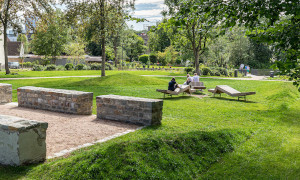The social issue of open space provision
- Anzeige Text im Grid: Nein
By Till Rehwaldt
With the current significant growth of many major cities, a trend has developed across the board that was long only known from the large metropolises such as Hamburg or Munich.
For many years, urban migration was the rule, also because there was sufficient open space available in the surrounding areas. Thus, for a long time, the emigrants themselves ensured a levelling out of living conditions and, to a certain extent, individually stood up for environmental justice.
With increasing building density, more and more municipalities are now facing the challenge of preserving public space as a valuable element of green infrastructure, but also developing it further with a view to more intensive use. In view of the discussions about the integration of refugees, politicians have also discovered the topic. The social issue of open space provision, i.e. an essential aspect of environmental justice, is currently in focus, see the Federal Government's White Paper on Urban Green Space.
The dilemma in which we find ourselves quickly becomes clear: For example, the universally audible call for "affordable housing" is politically and socially opportune, but not always particularly helpful from the perspective of open space development. In the search for quickly and cheaply available building sites, the focus is preferably on existing areas. Increasingly, new buildings are being placed in residential neighbourhoods with a high quality of open space developed over decades, which particularly affects long-time residents.
The strategy of double internal development is more important than ever before.
So in order to pursue environmentally sound urban development, a balance must be struck here; the strategy of double internal development is more important than ever before. This stands above all for the qualitative development of open space. If a negative land balance cannot be avoided, then at least a residential replacement must be created for the lost functions, for the encroachment on the immediate quality of life. So it is time to think about a "social intervention regulation". With the same care and concern that we give to the habitats of bats and lizards, we should take care of the human inhabitants.
It can be helpful to take a look at the supply of open space, which, in the sense of a general formulation of goals, first illuminates the quantitative aspect. Many municipalities are now paying greater attention to the balanced distribution and accessibility of green spaces and are placing this in the public focus as an aspect of quality of life. The city of Essen, for example, advertises that almost all residents can reach a public green space within 300 metres of their home.
However, if sufficient open space is not available in the immediate residential environment, the focus shifts not only to the functional intensification of individual facilities, but above all to greater networking. In this context, it is essential to define open space provision more precisely as an aspect of green infrastructure. An urban system of green spaces, especially quick accessibility also by bicycle, opens up new potentials. This year's exhibition "Fahr Rad" (Ride a Bike) at the German Architecture Museum in Frankfurt impressively pointed out this connection.
Ultimately, the strategy of environmental justice is not only a method of improving individual living conditions and eliminating social inequalities. There are also effects on society as a whole, in that mobility can be developed in an environmentally friendly way or green spaces can be maintained more economically.
Article by bdla President Till Rehwaldt, published as an editorial in the bdla association magazine "Landschaftsarchitekten" 4/2018.
- Latitude: 0
- Longitude: 0
bdla newsletter
Landscape Architecture
Announcements
Association


